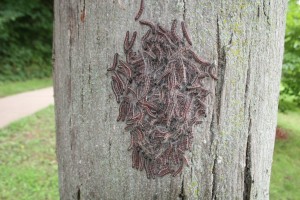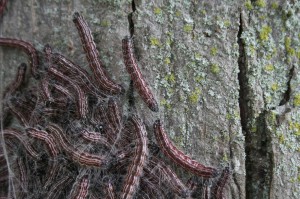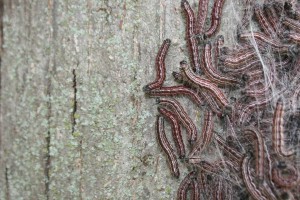(By Jared Hoyle, KSU Turfgrass Research and Extension)
What a beautiful day we had this year for the 2014 KSU Turfgrass Field Day. Thank you to all the attendees, vendors, sponsors, faculty, staff, students and anyone else that was out at the field day!
If you weren’t able to make it, I decided to post some pictures and links to research reports so you can get more information about each stop that we had this year.

Also, I will include the QR codes. These codes can be scanned by your phone and will take you directly to the information! Check it out!
 This year my stop at field day was “Kansas Turfgrass Weed Control Update”. Here is discussed one of the most problematic weeds in cool-season turfgrass, bermudagrass. I talked about both selective and non-selective methods. For more information about bermudagrass removal check it out here. https://blogs.k-state.edu/turf/non-selective-bermudagrass-removal/
This year my stop at field day was “Kansas Turfgrass Weed Control Update”. Here is discussed one of the most problematic weeds in cool-season turfgrass, bermudagrass. I talked about both selective and non-selective methods. For more information about bermudagrass removal check it out here. https://blogs.k-state.edu/turf/non-selective-bermudagrass-removal/

 KSU Turfgrass Research Technician and Graduate Student, Jake Reeves, presented information on the best management practices for buffalograss establishment. Jake has been conducting some great research that will really help us out when we want to convert cool-season turfgrass to buffalograss. For more information check out his latest blog post. https://blogs.k-state.edu/turf/establishing-buffalograss-in-golf-course-roughs/
KSU Turfgrass Research Technician and Graduate Student, Jake Reeves, presented information on the best management practices for buffalograss establishment. Jake has been conducting some great research that will really help us out when we want to convert cool-season turfgrass to buffalograss. For more information check out his latest blog post. https://blogs.k-state.edu/turf/establishing-buffalograss-in-golf-course-roughs/
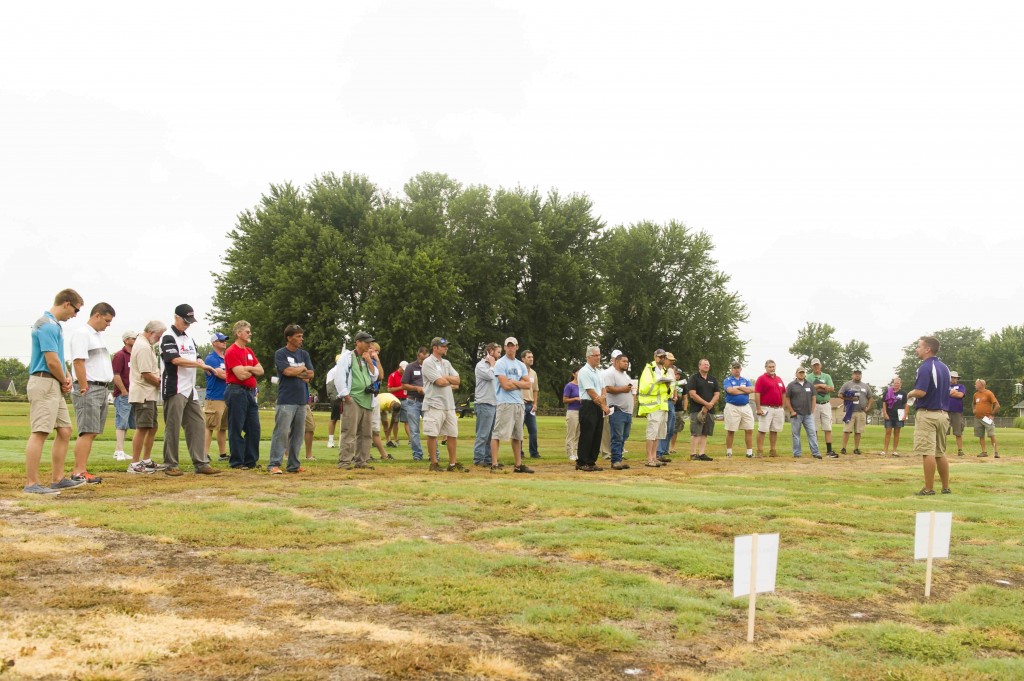
 Zane Raudenbush, KSU Turfgrass Graduate Student, and Dr. Keeley has been conducting research on the cultural management of moss infestations on bentgrass putting greens. Zane got to display some great looking research on one of the putting greens out at the Rocky Ford Turfgrass Research center looking at cultural practices in conjunction with chemical applications of carfentrazone. For more information check out his latest research report. http://www.ksre.ksu.edu/bookstore/pubs/SRP1107D-MOSS-FERTILITY.pdf
Zane Raudenbush, KSU Turfgrass Graduate Student, and Dr. Keeley has been conducting research on the cultural management of moss infestations on bentgrass putting greens. Zane got to display some great looking research on one of the putting greens out at the Rocky Ford Turfgrass Research center looking at cultural practices in conjunction with chemical applications of carfentrazone. For more information check out his latest research report. http://www.ksre.ksu.edu/bookstore/pubs/SRP1107D-MOSS-FERTILITY.pdf
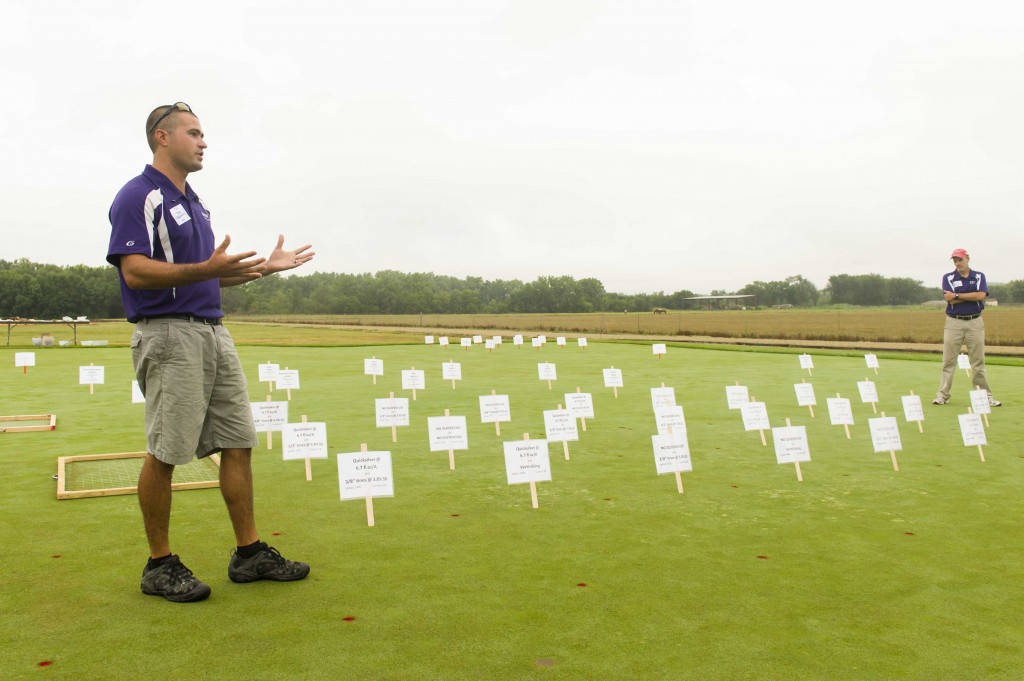
 Ever wondered what was the best preforming kentucky bluegrass cultivar? Well, Evan Alderman, KSU Turfgrass Graduate Student, discussed the best preforming Kentucky bluegrass cultivars in Manhattan, KS. This study is part of the Nation Turfgrass Evaluation Program (NTEP). Check out the NTEP website for the most current bluegrass cultivar information. http://www.ntep.org/data/kb11/kb11_14-2/kb11_14-2.pdf And some more information on prolonged drought and recovery characteristics of Kentucky bluegrass cultivars http://www.ksre.ksu.edu/bookstore/Item.aspx?catId=545&pubId=17861
Ever wondered what was the best preforming kentucky bluegrass cultivar? Well, Evan Alderman, KSU Turfgrass Graduate Student, discussed the best preforming Kentucky bluegrass cultivars in Manhattan, KS. This study is part of the Nation Turfgrass Evaluation Program (NTEP). Check out the NTEP website for the most current bluegrass cultivar information. http://www.ntep.org/data/kb11/kb11_14-2/kb11_14-2.pdf And some more information on prolonged drought and recovery characteristics of Kentucky bluegrass cultivars http://www.ksre.ksu.edu/bookstore/Item.aspx?catId=545&pubId=17861
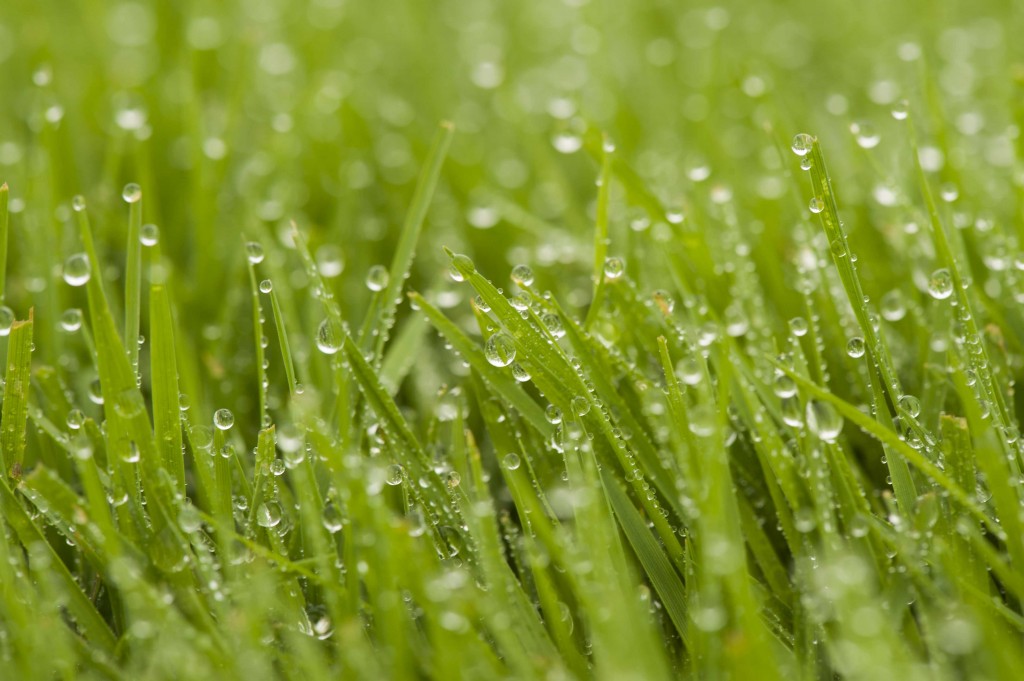
 Although this summer has seen to be pretty mild when it comes to diseases in turfgrass, Dr. Kennelly discussed both turf and landscape disease updates. Don’t forget to periodically check the blog as Dr. Kennelly updates the blog with what is going on with diseases in Kansas. Here is some more information on all sorts of turf disease publications. http://www.plantpath.ksu.edu/p.aspx?tabid=551
Although this summer has seen to be pretty mild when it comes to diseases in turfgrass, Dr. Kennelly discussed both turf and landscape disease updates. Don’t forget to periodically check the blog as Dr. Kennelly updates the blog with what is going on with diseases in Kansas. Here is some more information on all sorts of turf disease publications. http://www.plantpath.ksu.edu/p.aspx?tabid=551

 Is the grass really greener on the other side? Ross Braun, KSU Turfgrass Graduate Student, presented on using paints and pigments for coloring turfgrass. Ross has conducted many trials looking at painting zoysiagrass and buffalograss. He has evaluated different paints and pigments as well as rates and spray volumes. Check out his latest research update on paints and pigments. http://www.ksre.ksu.edu/bookstore/Item.aspx?catId=545&pubId=17867
Is the grass really greener on the other side? Ross Braun, KSU Turfgrass Graduate Student, presented on using paints and pigments for coloring turfgrass. Ross has conducted many trials looking at painting zoysiagrass and buffalograss. He has evaluated different paints and pigments as well as rates and spray volumes. Check out his latest research update on paints and pigments. http://www.ksre.ksu.edu/bookstore/Item.aspx?catId=545&pubId=17867
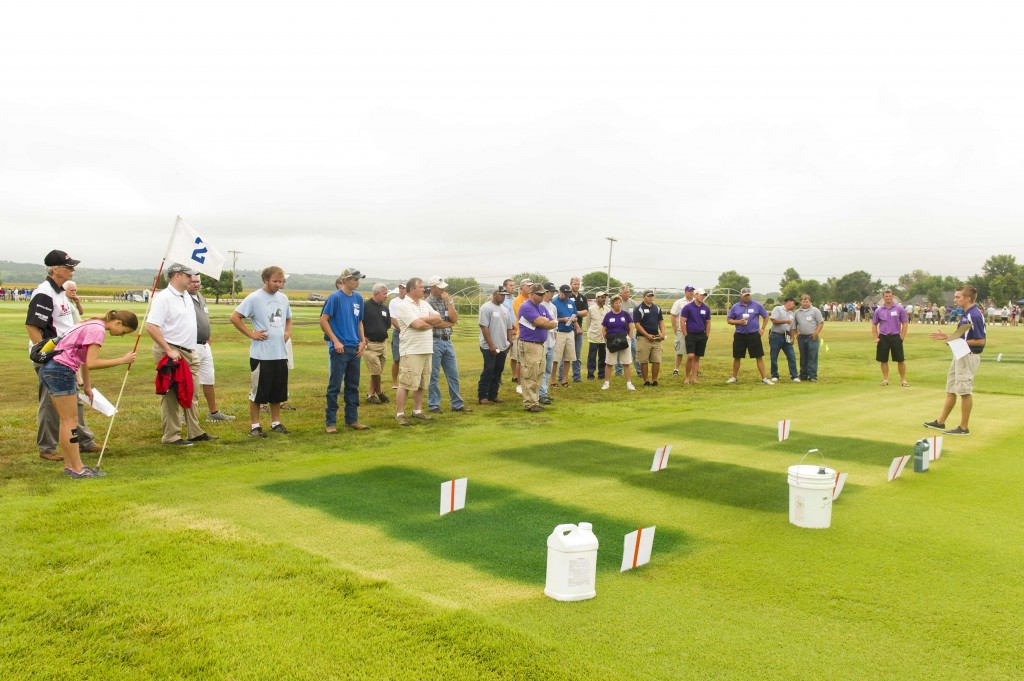
 As it is hard to grow cool-season turf in Kansas it is also tough to grow warm-season turf. Dr. Fry presented about the best zoysiagrass and bermudagrass cultivars for Kansas. He discussed everything from color to pest tolerance. This included information about how the cultivars held up to last winter. For more information about the zoysiagrass and bermudagrass cultivars here is a great research report about winter survival on the 2013 NTEP zoysiagrass and bermudagrass in Kansas. http://www.ksre.ksu.edu/bookstore/pubs/SRP1107G-NTEP-ZOYSIA-AND-BERMUDA.pdf
As it is hard to grow cool-season turf in Kansas it is also tough to grow warm-season turf. Dr. Fry presented about the best zoysiagrass and bermudagrass cultivars for Kansas. He discussed everything from color to pest tolerance. This included information about how the cultivars held up to last winter. For more information about the zoysiagrass and bermudagrass cultivars here is a great research report about winter survival on the 2013 NTEP zoysiagrass and bermudagrass in Kansas. http://www.ksre.ksu.edu/bookstore/pubs/SRP1107G-NTEP-ZOYSIA-AND-BERMUDA.pdf

 Weeds, diseases, and INSECTS! We can’t leave the insects out of field day. This year Dr. Cloyd also gave a turf and ornamental insect control update. For more information about insect control in the lawn and landscape, check out Dr. Cloyd’s list of publications. http://entomology.k-state.edu/extension/insect-information/lawn-garden-pests/lawn-pests.html
Weeds, diseases, and INSECTS! We can’t leave the insects out of field day. This year Dr. Cloyd also gave a turf and ornamental insect control update. For more information about insect control in the lawn and landscape, check out Dr. Cloyd’s list of publications. http://entomology.k-state.edu/extension/insect-information/lawn-garden-pests/lawn-pests.html

Find all the KSU Turfgrass Research Reports online at http://www.ksre.ksu.edu/bookstore/Category.aspx?id=528&catId=545.
Thanks again to everyone that came out to this years KSU Turfgrass Field Day. It was a great success and hope to see you next year in Olathe. Also, don’t forget this December is the Kansas Turfgrass Conference in Topeka. It’s going to be great as well. Keep and eye out for more information on registration.
